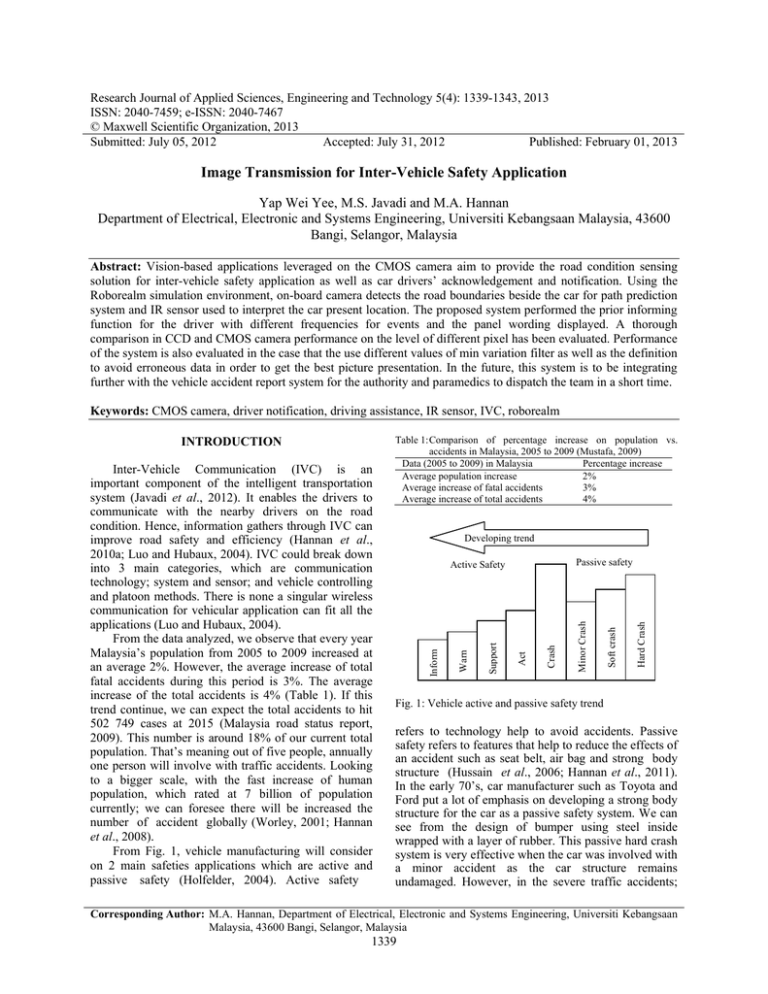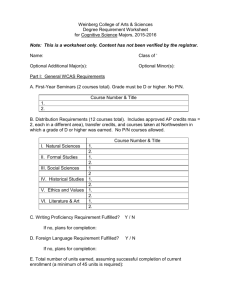Research Journal of Applied Sciences, Engineering and Technology 5(4): 1339-1343,... ISSN: 2040-7459; e-ISSN: 2040-7467
advertisement

Research Journal of Applied Sciences, Engineering and Technology 5(4): 1339-1343, 2013 ISSN: 2040-7459; e-ISSN: 2040-7467 © Maxwell Scientific Organization, 2013 Submitted: July 05, 2012 Accepted: July 31, 2012 Published: February 01, 2013 Image Transmission for Inter-Vehicle Safety Application Yap Wei Yee, M.S. Javadi and M.A. Hannan Department of Electrical, Electronic and Systems Engineering, Universiti Kebangsaan Malaysia, 43600 Bangi, Selangor, Malaysia Abstract: Vision-based applications leveraged on the CMOS camera aim to provide the road condition sensing solution for inter-vehicle safety application as well as car drivers’ acknowledgement and notification. Using the Roborealm simulation environment, on-board camera detects the road boundaries beside the car for path prediction system and IR sensor used to interpret the car present location. The proposed system performed the prior informing function for the driver with different frequencies for events and the panel wording displayed. A thorough comparison in CCD and CMOS camera performance on the level of different pixel has been evaluated. Performance of the system is also evaluated in the case that the use different values of min variation filter as well as the definition to avoid erroneous data in order to get the best picture presentation. In the future, this system is to be integrating further with the vehicle accident report system for the authority and paramedics to dispatch the team in a short time. Keywords: CMOS camera, driver notification, driving assistance, IR sensor, IVC, roborealm Developing trend Hard Crash Soft crash Crash Act Support Minor Crash Passive safety Active Safety Warn Inter-Vehicle Communication (IVC) is an important component of the intelligent transportation system (Javadi et al., 2012). It enables the drivers to communicate with the nearby drivers on the road condition. Hence, information gathers through IVC can improve road safety and efficiency (Hannan et al., 2010a; Luo and Hubaux, 2004). IVC could break down into 3 main categories, which are communication technology; system and sensor; and vehicle controlling and platoon methods. There is none a singular wireless communication for vehicular application can fit all the applications (Luo and Hubaux, 2004). From the data analyzed, we observe that every year Malaysia’s population from 2005 to 2009 increased at an average 2%. However, the average increase of total fatal accidents during this period is 3%. The average increase of the total accidents is 4% (Table 1). If this trend continue, we can expect the total accidents to hit 502 749 cases at 2015 (Malaysia road status report, 2009). This number is around 18% of our current total population. That’s meaning out of five people, annually one person will involve with traffic accidents. Looking to a bigger scale, with the fast increase of human population, which rated at 7 billion of population currently; we can foresee there will be increased the number of accident globally (Worley, 2001; Hannan et al., 2008). From Fig. 1, vehicle manufacturing will consider on 2 main safeties applications which are active and passive safety (Holfelder, 2004). Active safety Table 1: Comparison of percentage increase on population vs. accidents in Malaysia, 2005 to 2009 (Mustafa, 2009) Data (2005 to 2009) in Malaysia Percentage increase Average population increase 2% Average increase of fatal accidents 3% Average increase of total accidents 4% Inform INTRODUCTION Fig. 1: Vehicle active and passive safety trend refers to technology help to avoid accidents. Passive safety refers to features that help to reduce the effects of an accident such as seat belt, air bag and strong body structure (Hussain et al., 2006; Hannan et al., 2011). In the early 70’s, car manufacturer such as Toyota and Ford put a lot of emphasis on developing a strong body structure for the car as a passive safety system. We can see from the design of bumper using steel inside wrapped with a layer of rubber. This passive hard crash system is very effective when the car was involved with a minor accident as the car structure remains undamaged. However, in the severe traffic accidents; Corresponding Author: M.A. Hannan, Department of Electrical, Electronic and Systems Engineering, Universiti Kebangsaan Malaysia, 43600 Bangi, Selangor, Malaysia 1339 Res. J. Appl. Sci. Eng. Technol., 5(4): 1339-1343, 2013 the car driver will receive a great impact due to the hard crash design that has a very small time impact and hence the force to the car driver enormously big (Hannan et al., 2006). Fatality rate of the car driver increase tremendously. In the late 80’s, there are more and more an emphasis for car manufacturer to focus on active safety which are the precaution before the accident happened (Hannan et al., 2010b). The latest car design Ford Fusion to be released at 2013, integrate an active safety system such as lane keeping system, driver alert systems, adaptive cruise control, active park assisted system, pull drift compensation and blind sport indicator system inside this car. All these traditional active control systems had a limitation. Inter-Vehicle Communication (IVC) is able to overcome the weakness of the traditional active control system to increase safety by enhancing interactive communication between all nodes on the road. IVC pre-inform the car driver on the event out of the Line of sight, LOS of the car driver (Tsugawa, 2005). Hence, the car driver will get to inform and worn on the event before the car driver moving into that region. This study focuses on leverage on the various sensor systems namely: Infrared line detecting system and CMOS camera to act as driver assistance and nearby car notification using series transceiver KYL200U sending data in a digital bit for safety application. The usage of CMOS camera was due to its high availability; reliability; low-cost and sensitivity. The signal processed in 3 bits digital data so that it had less significant delay processed issue, erroneous data and required less sophisticated communication protocol. SYSTEM DEVELOPMENTS Fig. 2: System interface Fig. 3: Hardware interface white line beside the road. The processed data which contain the location of the car send to the PIC 16F877A microcontroller. This system exploits on the servo motor controlling module available in Roborealm environment to control the Futaba Servo motor. Hardware Implementation include connecting the computer and PIC 16F877A with a RS232 receiver/connector through the chip MAX 232 parallels to the series converter. Active RFID used to identify the identity of the nearby car to establish the communication between the drivers using beaconing single-hop method. The digital signals consist of 3 bits used to inform the near-by car driver in the occasion of pre-event danger. The third part consists of sent data/ payload and established inter vehicle communication. The data encoded into 3 bits to inform the nearby car as well as driver assistance. The data displayed in forms of different frequency beeping, text display and gentle warning notification. Driver drives their vehicles in 3 sequential steps recognize, decision and action (Ito, 2007). This system’s works consist of 3 main parts and one part on the future implementations as shown in Fig. 2. The first part interfaced all the sensors and calibration. This RFID sensor functioned as nearby car identification and established communication protocol. IR sensor was to detect the white line within the car road path using digital bit and act as present location detection. CMOS camera was to detect the distance of the white line correspond to the future possible path of the car and possible potential obstacles in front of the car. The second parts of works were determined and established the controlling mechanism and protocol using PIC 16F877A as shown in Fig. 3. The 8 bit digital data directly interfaced and connected to the PORT B RESULTS AND DISCUSSION of the PIC 16F877A. The CMOS camera captured moving picture analyzed with on-board computer unit The total distance over a specific distance is shown using Roborealm environment. This involved coding to in Fig. 4 in which the total distance is less than 100 for change the moving picture to grey scale to detect the 1340 Res. J. Appl. Sci. Eng. Technol., 5(4): 1339-1343, 2013 375 Level 300 225 150 75 0 50 100 150 200 250 300 350 400 450 500 Fig. 4: Total distance with different level Fig. 5: CCD histogram light intensity and level Fig. 6: CMOS histogram light intensity and level the first 50 ms period and then the data to be sent is 010 to correspond one another car. The data is saved in the temp folder under variable.txt in which the total distance between 100-250 is considers a safe distance and also corresponded to the data of 000. If the total distance is more than 375, the data 011 which correspond to danger, moving into other lanes is issued. 011 data also mean there is an obstacle in front and prompt the car driver to apply the emergency brake. The sending data in terms of voice warning and different beeping frequency help. There are issues with the light sensitivity of the car camera. In this system, Complementary Metal Oxide Semiconductor (CMOS) AVF 7.5 Mega pixels webcam was used. The issue on the CMOS camera was low light sensitivity. The Roborealm software changes the picture into the grey scale and detecting the white portion. Hence from Fig. 5, under the same road condition, camera mid tones setting and light; the CCD, charge coupled device laptop builds in camera can detect more different pixel of color and higher light intensity compare with CMOS camera CCD present excellent performance and image quality due to extremely low noise, low dark current, high quantum efficiency and fill factor (Blanc, 2001). However, CCD consumed a lot of power, 100 times greater than CMOS camera and the price of CCD normally more expensive than CMOS camera because it can be manufactured in any standard silicon production line. Freescale smart car operated on 7.2 V low power nickel-cadmium battery; hence from Fig. 6, CMOS camera most suitable with its low-power consumption ability. However, it required a normal room brightness 200 LUX level in order to receive a good signal. For further implementation in night environment, a few LED required to place it right at in front the Left wheel of the car. Figure 7 shows the variation of cog area with respond to the filter minimum intensity. From the Fig. 7, we observed that when the value of minimum filter intensity getting smaller approach zero; the cog area increased further to maximum 2500. If the filter intensity got bigger, approached 200, the cog area would be almost equal to zero. The cog area effective used to determine the sensitivity of the CMOS camera towards detected the white line beside the road at different environment. When in the morning when the system had sufficient light intensity, the minimum filter value should decrease to prevent the erroneous data detected. The erroneous data perceived the reflected light from the wet surface of the road interpreted as the white line of the road. When in the night, the minimum filter value should be increased to derive more accurate data. Figure 7 shows the variation of cog area with respond to the filter minimum intensity. When the value of minimum filter intensity is equal to 180; the cog area is within 500 to 1000. If the minimum filter intensity decreases to 150, observed there was a sharp peak followed by saturate at around 1000. If the further decrease the minimum filter intensity to 120, observed that the cog area fluctuated within 1000 to 1500. The further decrease the minimum filter intensity, the cog area had a sharp rise to within 2500. The further decreases of the minimum filter intensity not contributed further to the cog area. If the minimum filter intensity is increased further to 199, the cog area decreases almost to zero. The cog varies with the different light intensity; the higher the light intensity, the higher the level of cog variation as shown in Fig. 8. The cog is an effective used to determine the sensitivity of the CMOS camera towards detecting the white line beside the road at different environment. Our camera needs to determine 1341 Res. J. Appl. Sci. Eng. Technol., 5(4): 1339-1343, 2013 Fig. 7: Cog area responded with the variation of filter min intensity surrounding light contributed to the problems of minimum filter value to be determined. When in the morning when the environment had sufficient light intensity, the minimum filter value should be decrease to prevent the erroneous data to be detected. For example, the erroneous data perceive the reflected light from the wet surface of the road to be interpreted as the white line of the road. However, when in the night, the minimum filter value should be increased to be able to getting more accurate data. The Cog density is using the formula of a Cog weight divide by Cog area. It is observed that the density is fluctuating within the value of 1 to 2 as shown in Fig. 9. To get a good and sharp result, the minimum intensity filtering should get a highest possible Cog density which gets a high Cog weight correspond to high intensity of filtered light at the same time the Cog area should be as minimum as possible to reduce the possibility of erroneous data. Performance of the system depends on the light intensity of surrounding, the calibrated filter value, surrounding noise and the speed of travel of the vehicle. Hence in future development, the system will focus on increase the system performance with the calibrated parameters. 450000 Level 375000 300000 225000 150000 75000 50 100 150 200 250 300 350 400 450 0 Fig. 8: Cog variation with the light intensity Level 3 2 1 0 50 100 150 200 250 300 350 400 450 500 CONCLUSION Fig. 9: Cog density the minimum Cog area so that have a more accurate point to determine the distance between the Cog X, Y and the center of the image. If there a big area of Cog exists, the encoded signal error bigger. However, the In this study, inter-vehicle driving assistance system leverage on the CMOS camera provides driving assistance as well as nearby car notification to increase road efficiency and safety has been discussed. It tracked 1342 Res. J. Appl. Sci. Eng. Technol., 5(4): 1339-1343, 2013 the white line beside the driving lane and issued a combinational of beeping warning, sound notification as well as wording display. It gives the driver information of the road condition in advance as well as alerts the sleepy driver in the highways. In future, the system is going to focus on storing the image before the accident happens and disseminates the information to the nearby authority for the fastest and efficient help dispatched to the scene. REFERENCES Blanc, N., 2001. CCD Versus CMOS- Has CCD Imaging Come to an End?. Photogrammetric Week ’01, Herbert Wichmann Verlag, Heidelberg, pp: 131-137. Hannan, M.A., A. Hussain, S.A. Samad, A. Mohamed, D.A. Wahab and K.A.M. Ihsan, 2006. Development of an intelligent safety system for occupant detection, classification and position. Int. J. Automotive Technology (IJAT), 7(7): 827-832. Hannan, M.A., A. Hussain, A. Mohamed and S.A. Samad, 2008. Development of an embedded vehicle safety system for frontal crash detection. Int. J. Crashworthiness, 13(5): 579-587. Hannan, M.A., A. Hussain, A. Mohamed, S.A. Samad and D.A. Wahab. 2010a. Decision fusion of a multi-sensing embedded system for occupant safety measures. Int. J. Automot. Technol., 11(1): 57-65. Hannan, M.A., A. Hussain and S.A. Samad, 2010b. System interface for an Intelligent Safety System (ISS) for vehicle applications. Sensors, 10(1): 1141-1153. Hannan, M.A., A. Hussain and S.A. Samad, 2011. Sensing systems and algorithms for airbag deployment decision. IEEE Sens. J., 11(4): 888-890. Holfelder, W., 2004. Vehicle to Vehicle, Vehicle to Infrastructure Communication Recent Development, Opportunity and Challenges. Retrieved from: http://aswsd.ucsd.edu/2004/ pdfs/ V2VandV2ICommunication-Paper-WHolfelderDraft.pdf. Hussain, A., M.A. Hannan, A. Mohamed, H. Sanusi and K.A.M. Ihsan, 2006. Vehicle crash analysis for airbag deployment decision. Int. J. Automotive Technol., 7(2): 179-185. Ito, M., 2007. Development of inter-vehicle communication driving support system in the ASV-3 project. Mitsubishi Motors Technical Rev., No. 19: 46-50. Javadi, M.S., M.A. Hannan, S.A. Samad and A. Hussain, 2012. A robust vision-based lane boundaries detection approach for intelligent vehicles. Inform. Technol. J., 11(9): 1184-1192. Luo, J. and J.P. Hubaux, 2004. A survey of intervehicle communication. Technical Report IC/2004/24, EPFL. Malaysia road status report, 2009. Mustafa, M.N., 2009. Overview of Current Road Safety in Malaysia. Highway Planning Unit, Road Safety Section, Ministry of Works Malaysia. Tsugawa, S., 2005. Issues and recent trends in vehicle safety communication systems. In IATSS Research, 29(1): 7-15. Worley, H., 2001. Road Traffic Accidents Increase Dramatically Worldwide. Retrieved from: http:// www. prb. org/ Articles/ 2006/ Road Traffic Accidents Increase Dramatically Worldwide. aspx/. 1343



